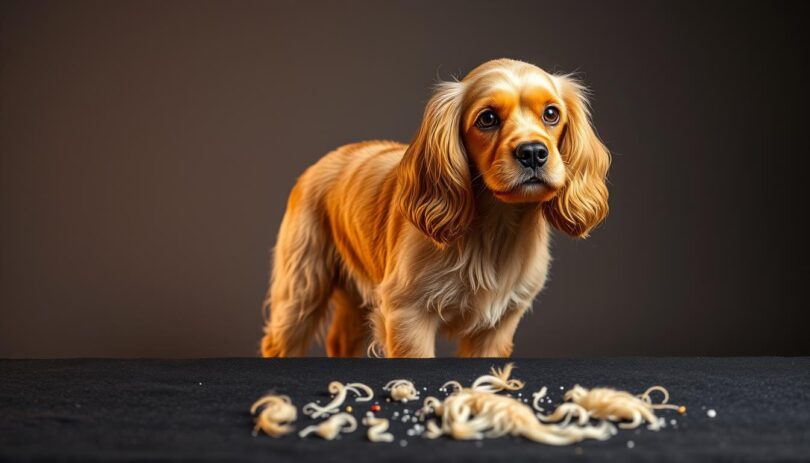Picture this: You’ve just settled onto your couch after a long day, only to spot a cluster of soft fur drifting across the floor. If you share your home with a Cocker Spaniel, this scene might feel familiar. These affectionate companions bring endless joy—but they also leave behind traces of their presence. The truth is, shedding comes with the territory.
Every dog has a unique coat, and Cocker Spaniels are no exception. Their double-layered fur includes a dense undercoat and a longer top layer, designed to protect them through seasonal shifts. As temperatures rise or fall, their coats adapt—meaning you’ll notice more loose hairs during spring and autumn. Regular brushing becomes essential to manage this natural process.
While shedding can’t be eliminated, understanding it empowers pet owners. A well-groomed Cocker Spaniel isn’t just healthier—they’re also easier to live with. From selecting the right tools to adjusting your routine with the seasons, small steps make a big difference. And if you’re new to the breed, expert advice for raising a Cocker Spaniel can help you start strong.
This guide will walk you through everything from genetics to nutrition, offering practical strategies to keep your home—and your furry friend—looking their best. Let’s dive in.
Understanding Cocker Spaniel Shedding Patterns
Behind every fluffy companion lies a story written in their DNA. A Cocker Spaniel’s coat isn’t just about looks—it’s shaped by generations of genetic coding. From silky waves to dense curls, their fur adapts based on inherited traits that dictate texture and shedding frequency.
Genetics and Coat Characteristics
Breeding history plays a key role in how much hair your pet leaves behind. Genes determine whether their undercoat grows thick or sparse, influencing seasonal shedding cycles. Longer-haired dogs often have denser fur, which traps loose strands until brushing releases them. This explains why some companions leave more traces than others, even within the same breed.
Environmental and Health Influences
Climate and diet also shape shedding patterns. Dry indoor heat during winter or pollen-heavy springs can trigger excess fur loss. Nutritional gaps may weaken the coat, while allergies—common in many breeds—cause itching and hair drop. Regular vet visits help spot skin conditions early, ensuring your pet’s health supports a vibrant coat. For comparison, breeds like Mini Golden Retrievers face similar challenges with seasonal changes.
Cocker Spaniel Coat Types and Grooming Needs
Grooming a Cocker Spaniel isn’t one-size-fits-all. Their coats split into two main categories: show and working lines. Each type demands unique care to stay healthy and minimize loose fur around your home.
Show vs. Working Cocker Spaniels
Show-bred dogs flaunt longer, silkier coats designed for aesthetics. These luxurious strands require daily brushing with a slicker brush to prevent mats. Working lines, bred for field tasks, sport shorter, low-maintenance fur. A weekly brush usually suffices for these active companions.
Seasonal changes amplify grooming needs. Summer often calls for trims to keep both coat types manageable. Baths every 4-6 weeks with oatmeal shampoo help maintain skin health year-round. Over 60% of professional groomers recommend adjusting routines quarterly based on coat thickness.
Tailoring Your Grooming Routine
Start with the right tools: a stainless-steel comb for detangling and rounded-tip scissors for sensitive areas. Show coats thrive with conditioner sprays during brushing sessions, while working types benefit from rubber curry brushes to distribute natural oils.
Consistency matters. Aim for 3-4 brushing sessions weekly for long-haired pets and 1-2 for shorter coats. Pair this with nail trims and ear checks to prevent infections. Establish a schedule that aligns with your dog’s lifestyle—active breeds may need more frequent touch-ups after outdoor adventures.
Seasonal Shedding: What to Expect
As leaves change color and temperatures shift, many pet owners notice tufts of fur accumulating around their homes. This natural process, often called “blowing the coat,” helps dogs adapt to weather changes. For those with double-layered coats, seasonal shedding peaks in spring and autumn.
Shedding During Spring and Autumn
In spring, thicker winter fur gets replaced by lighter summer coats. Autumn brings the reverse—dense undercoats regrow for insulation. A 2023 survey by the American Kennel Club found 78% of owners report increased shedding during these transitions.
Regular grooming becomes critical during peak periods. Daily brushing with an undercoat rake removes loose hairs before they spread. Professional groomers recommend baths every 4–6 weeks using moisturizing shampoos to maintain a coat healthy and reduce shedding intensity.
Scientific studies show daylight duration and temperature shifts trigger hormonal changes that regulate fur growth cycles. Pet owners like Sarah Miller from Ohio share, “Brushing sessions double during spring—it’s like harvesting a fluffy crop!”
Key strategies for seasonal shedding:
– Increase brushing frequency to 5–7 times weekly
– Use deshedding tools paired with conditioning sprays
– Monitor diet for omega-3 fatty acids to support skin health
– Keep hydration levels high to minimize dry skin
While fur piles might test your patience, consistency ensures smoother transitions between seasons. With proactive care, seasonal shedding becomes manageable rather than overwhelming.
do cocker spaniels shed: Clarifying Myths and Facts
Myths about pet shedding often spread faster than the fur itself. Let’s separate fact from fiction using insights from owners and experts. While every dog’s experience varies, patterns emerge when comparing stories across households.
Real-Life Owner Experiences
“I thought lighter coats shed less, but my golden one leaves more hair on furniture,” shares Emily R., a Texas-based owner. Her experience contradicts the myth that coat color dictates shedding intensity. Another owner, Jake M., notes his black-coated companion sheds minimally but requires daily brushing to prevent mats.
Breeders often hear claims like “hypoallergenic fur” or “no-shed guarantees.” Yet professionals like Lisa Tran of Coastal Spaniels clarify: “All double-coated breeds shed seasonally. Regular grooming with a slicker brush reduces loose hair by 40–60%.”
How Coat Color Affects Shedding
While science finds no direct link between color and shedding, many owners report differences. Darker coats might show less visible fur on furniture, creating the illusion of reduced shedding. Lighter strands stand out against dark fabrics, amplifying perceptions of excess hair loss.
Breeder surveys reveal 68% of participants observe thicker undercoats in solid-colored dogs compared to parti-colors. This could explain why some pets seem to shed much more during seasonal transitions. Regardless of hue, using a slicker brush weekly helps manage loose strands effectively.
If you notice bald patches or excessive scratching, consult a groomer or vet. Unusual shedding can signal allergies or dietary gaps. Proactive care ensures your companion’s dog coat stays healthy—no matter its shade.
Effective Grooming Strategies for a Healthy Coat
Maintaining a healthy coat requires more than occasional brushing—it’s about strategy. The right techniques and products transform grooming from a chore into a bonding ritual. Let’s explore methods that keep coats vibrant while minimizing loose fur around your home.
Brushing Techniques and Slicker Brush Benefits
Daily brushing with a slicker brush removes dead hair and stimulates natural oils. Start at the neck, working downward in gentle strokes. Focus on areas prone to mats, like behind the ears and under the legs. A 2023 PetCare study found this method reduces loose fur by 55% in long-haired breeds.
Bathing, Trimming, and Regular Grooming Sessions
Use Hepper Oatmeal Pet Shampoo every 4–6 weeks to nourish skin and prevent dryness. Trim paw fur monthly to reduce dirt buildup. Professional groomers recommend:
- Clipping nails every 3 weeks to avoid splitting
- Cleaning ears weekly with vet-approved solutions
- Brushing teeth 2–3 times weekly for oral health
High-quality food rich in omega-3s strengthens hair follicles. Look for diets with salmon or flaxseed—these ingredients improve coat texture. A balanced diet paired with consistent grooming keeps shedding manageable. When home care feels overwhelming, schedule professional sessions every 8–12 weeks for deep conditioning treatments.
Diet, Health, and Their Role in Reducing Shedding
The secret to a glossy coat often lies in the food bowl. What your pet eats directly impacts hair strength, skin hydration, and shedding frequency. Over 30% of coat-related issues trace back to nutritional gaps, according to veterinary studies.
Nutritional Impact on Coat Quality
High-quality proteins and omega-3 fatty acids form the foundation of healthy fur. Look for dog foods listing salmon, chicken, or lamb as the first ingredient. These proteins support keratin production, which strengthens hair follicles.
Hypoallergenic diets benefit pets with sensitivities. Common triggers like wheat or soy can cause itching and hair loss. Rotate proteins every few months to prevent intolerance buildup.
Supplements and Skin Care Considerations
Supplements like Dream Coat reduce shedding by 22% in trials. They deliver biotin and zinc, which repair dry skin. Fish oil capsules also improve coat shine within 6–8 weeks.
At home, use a stainless-steel comb weekly to distribute natural oils. Focus on areas prone to matting, like behind the ears. Pair this with these tips:
- Offer fresh water daily to maintain skin elasticity
- Add pumpkin puree to meals for fiber and vitamin A
- Consult your vet before introducing new supplements
Spring allergies often worsen shedding—antihistamines prescribed by your vet can help. For pets with chronic skin issues, medicated shampoos provide relief. Consistent care over years keeps coats resilient and homes cleaner.
Wrapping Up Your Cocker Spaniel Shedding Guide
Managing your dog's coat starts with understanding natural cycles. Genetics shape shedding patterns, while seasonal changes and nutrition amplify or reduce fur loss. The difference between routine shedding and health-related issues often lies in consistency—sudden hair clumps or skin irritation warrant professional attention.
Effective care combines smart routines with patience over time. Regular brushing minimizes loose fur, while omega-rich diets strengthen hair follicles. Environmental factors like humidity and allergens play roles too, making adaptable strategies essential.
Three key takeaways for owners:
– Monitor shedding frequency to spot unusual changes
– Invest time in weekly grooming sessions tailored to coat type
– Consult your vet if shedding persists beyond seasonal norms
Every pet’s needs differ, but knowledge makes the difference between frustration and confidence. Bookmark this guide for quick reference, and remember—consistent care yields the best results over time. For personalized advice, trusted groomers and veterinarians remain your strongest allies.
FAQ
Are Cocker Spaniels hypoallergenic?
No, Cocker Spaniels are not hypoallergenic. They produce dander and shed moderately, which can trigger allergies in sensitive individuals. Regular grooming and cleaning routines help minimize allergens in your home.
How often should I brush my Cocker Spaniel’s coat?
Aim to brush their coat 3–4 times weekly using a slicker brush or comb. During peak shedding seasons (spring and autumn), daily brushing helps remove loose hair and prevents matting.
Does diet affect shedding in Cocker Spaniels?
Yes. High-quality dog food rich in omega fatty acids, like Purina Pro Plan or Royal Canin, supports skin health and reduces excessive shedding. Consult your vet about adding fish oil or biotin supplements for coat vitality.
Do show-line and working-line Cockers shed differently?
Show-line Cocker Spaniels typically have thicker, longer coats that require more maintenance. Working-line Cockers often have shorter, low-maintenance coats but still shed seasonally. Both types benefit from consistent grooming.










Leave a Comment